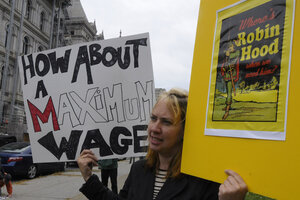Top 100 CEOs have more retirement savings than 116 million Americans
A new study reveals that the gap in retirement plans between executives and workers may be worse than the gap in pay. The top 100 CEOs in the US have more retirement assets than 41 percent of Americans.

Laura Hartmark, of Albany, N.Y., holds two protest signs while supporting the Occupy Wall Street movement in Albany, N.Y., Friday, Oct. 21, 2011.
Hans Pennink/AP/File
A study released Wednesday reveals 100 CEOs have more in their retirement plans than 41 percent of American families combined.
The new study, titled A Tale of Two Cities, finds that 100 Fortune 500 CEOs have retirement assets worth $4.9 billion collectively, roughly equal to the amount saved by 50 million US families. To calculate the CEOs' retirement packages, left-leaning Institute for Policy Studies and the Center for Effective Government researched SEC filings and other public documents. Their findings suggest that the average Fortune 500 CEO will have around $49.3 million saved up by the time he retires.
The strategies used to achieve the massive nest eggs are typically tax-deferred and unavailable to the average worker. “Seventy-three percent of Fortune 500 firms have also set up special tax-deferred compensation accounts for their executives,” the study reads. These tax plans are similar to widely available 401(k) plans, but plans accessible to most workers have a cap of $18,000 a year. The executive plans have no cap, meaning an unlimited amount of money can grow free of tax burdens until retirement.
Bloomberg Business found that in addition to tax-deferred retirement plans, around 30 percent of Fortune 1000 companies offer additional executive retirement plans as added incentive. Such plans are typically calculated from the executive's years of service and the average pay of his last years at the company.
"These benefits weren’t originally intended to be huge wealth generators but they’ve become that as CEO compensation has grown to 200 to 300 times what average workers make," Gary Hewitt, the director of governance research for Sustainalytics, a leading sustainable investment analysis firm, told Bloomberg Business. "They’re harder to justify as companies have abandoned worker pensions."
The CEO with the biggest retirement investment haul is Yum! Brands’s CEO David C. Novak with $234.2 million His monthly payment throughout retirement would be $1.3 million. Meanwhile, Yum! Brands, which owns the KFC, Pizza Hut, and Taco Bell restaurant chains, eliminated pension plans for employees who joined the company after 2002 and replaced them with 401(k) plans.
The median retirement account balance for near-retirement households is $14,500, according to The National Institute on Retirement Security.
The attention given to CEO pay and, now, retirement plans is the latest in an ongoing national discussion about wealth inequality. It took center stage in 2011 with the Occupy Movement in the US and has gained increased attention as the presidential campaign season gets underway.
So far, the discussion, and new rules including compensation-related disclosure requirements from the SEC, have focused mainly on the gap between worker and CEO pay. But the income gap isn't the only issue, experts say.
“This CEO-to-worker retirement gap is a lot bigger than the pay gap and one more indicator of the extreme level of inequality that is really tearing the country apart,” said Sarah Anderson, the retirement report’s co-author and the global economy project director at the Institute for Policy Studies, in the report's release.

